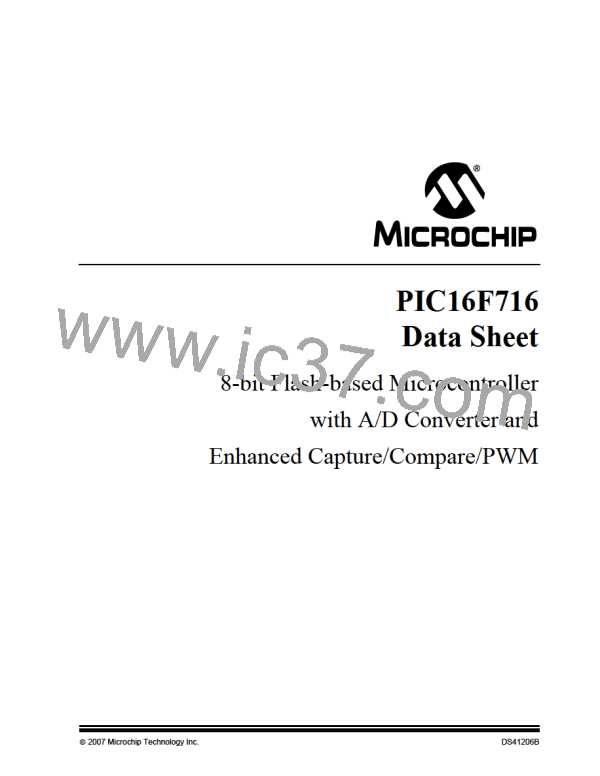PIC16F716
7.1.3
ADC VOLTAGE REFERENCE
7.1
ADC Configuration
The PCFG bits of the ADCON0 register provide
independent control of the positive voltage reference.
The positive voltage reference can be either VDD or an
external voltage source.
When configuring and using the ADC the following
functions must be considered:
• Port configuration
• Channel selection
7.1.4
CONVERSION CLOCK
• ADC voltage reference selection
• ADC conversion clock source
• Interrupt control
The source of the conversion clock is software select-
able via the ADCS bits of the ADCON0 register. There
are four possible clock options:
7.1.1
PORT CONFIGURATION
• FOSC/2
The ADC can be used to convert both analog and digital
signals. When converting analog signals, the I/O pin
should be configured for analog by setting the associated
TRIS and ADCON1 bits. See the corresponding Port
section for more information.
• FOSC/8
• FOSC/32
• FRC (dedicated internal oscillator)
The time to complete one bit conversion is defined as
TAD. One full 8-bit conversion requires 9.5 TAD periods.
Note:
Analog voltages on any pin that is defined
as a digital input may cause the input
buffer to conduct excess current.
For correct conversion, the appropriate TAD specification
must be met. See A/D conversion requirements in
Section 12.0 “Electrical Characteristics” for more
information. Table 7-1 gives examples of appropriate
ADC clock selections.
7.1.2
CHANNEL SELECTION
The CHS bits of the ADCON0 register determine which
channel is connected to the sample and hold circuit.
Note:
Unless using the FRC, any changes in the
system clock frequency will change the
ADC clock frequency, which may
adversely affect the ADC result.
When changing channels, a delay is required before
starting the next conversion. Refer to Section 7.2
“ADC Operation” for more information.
TABLE 7-1:
TAD vs. DEVICE OPERATING FREQUENCIES
Device Frequency
AD Clock Source (TAD)
Operation
2 TOSC
8 TOSC
32 TOSC
RC
ADCS<1:0>
20 MHz
100 ns(2)
400 ns(2)
1.6 μs
5 MHz
400 ns(2)
1.25 MHz
1.6 μs
6.4 μs
25.6 μs(3)
2-6 μs(1), (4)
333.33 kHz
6 μs
24 μs(3)
96 μs(3)
2-6 μs(1)
00
01
10
11
1.6 μs
6.4 μs
2-6 μs(1), (4)
2-6 μs(1), (4)
Legend: Shaded cells are outside of recommended range.
Note 1: The RC source has a typical TAD time of 4 μs.
2: These values violate the minimum required TAD time.
3: For faster conversion times, the selection of another clock source is recommended.
4: When device frequency is greater than 1 MHz, the RC A/D conversion clock source is recommended for
Sleep operation only.
DS41206B-page 38
© 2007 Microchip Technology Inc.

 MICROCHIP [ MICROCHIP ]
MICROCHIP [ MICROCHIP ]